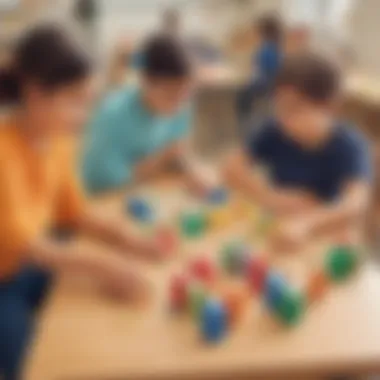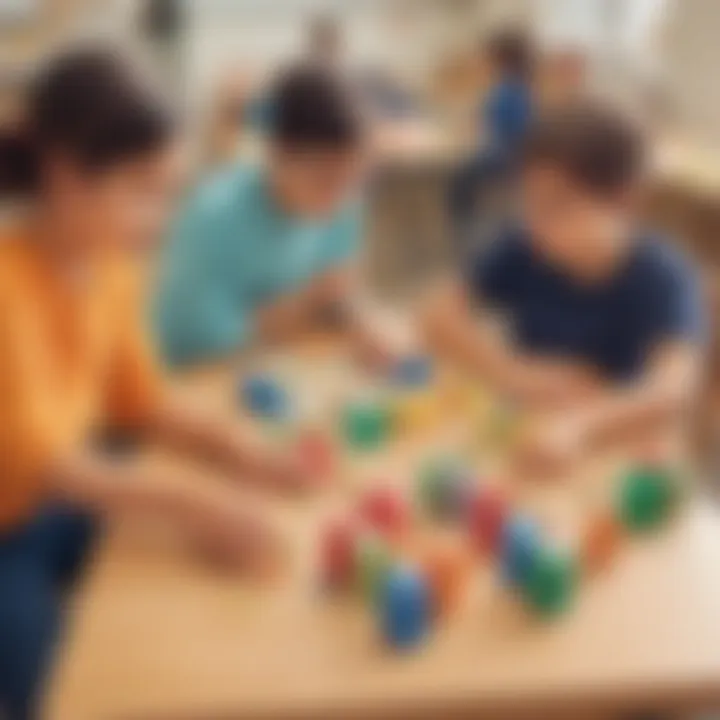Effective Strategies for Teaching Division to Struggling Students


Intro
Teaching division to students who struggle with this mathematical concept poses unique challenges for educators. Understanding the root causes of these difficulties can aid in selecting effective instructional strategies. This article will delve into various methods, with a focus on creative activities that enrich the learning experience. By fostering an environment where learning division is engaging and meaningful, we can help students develop confidence and mastery in this essential skill. Positive learning experiences are vital for nurturing a child's mathematical abilities.
Creative Activities
Craft Ideas
Hands-on activities are an excellent way to solidify the understanding of division concepts. Here are a few craft ideas:
- Group Division Tasks: Use paper plates to demonstrate division visually. Divide the plates into sections to represent different groups.
- Sticky Note Division: Write numbers on sticky notes, then have students create groups of those numbers on their desks. This tangible method helps students see and understand the process.
- Building Blocks: Using blocks to illustrate division can be engaging. For example, take various sets of blocks and arrange them into distinct groups based on division problems.
Step-by-Step Guides
Here are detailed instructions for one of the crafts:
- For Group Division Tasks:
- Gather several paper plates and markers.
- Explain to students that each section of the plate represents a group in division.
- Choose a division problem, e.g., 12 divided by 4.
- Draw 4 equal sections on the plate and ask students to help distribute items (like counters) equally into the sections.
- Discuss with students how many items are in each group after division.
Educational Value
The educational benefits of these activities are significant. They encourage active participation, cater to various learning styles, and help establish concrete understanding. Engaging in crafts not only makes division relatable but also enhances critical thinking and problem-solving skills in students.
Fun Quizzes
Quiz Topics
Quizzes can serve as a vital tool for reinforcing division concepts. Topics to include may cover:
- Basic division facts
- Long division
- Word problems involving division
- Real-world applications of division
Question Types
To keep children engaged, quizzes should include a variety of question types:
- Multiple-choice questions for quick assessments.
- Fill-in-the-blank problems to gauge understanding.
- Matching exercises that connect division terms with their meanings.
Knowledge Reinforcement
These quizzes can significantly help in reinforcing learning. By revisiting division concepts in a fun and interactive way, students solidify their knowledge and gain confidence. Regular practice through quizzes can also reveal areas that may need additional focus.
Fact-Based Articles
Topics
Offering fact-based articles that cover several division concepts can be beneficial for expanding a child’s knowledge. Topics can include:
- Historical development of division methods
- Applications of division in technology and coding
- Fun facts about division in daily life
Engaging Content
Fact-based articles should present information in an engaging and straightforward manner. Short paragraphs, clear headings, and bullet points can help maintain student interest and enhance comprehension.
Understanding Division
Division is a fundamental concept in mathematics that allows us to understand how quantities are shared or grouped. For students who struggle, grasping this concept can be a daunting task. Emphasizing the understanding of division is crucial for making sense of more complex mathematical operations in the future. This section will highlight what division is and why it is significant for students.
Definition of Division
Division can be understood as the process of splitting a number into equal parts. To define it simply, if we have a number called the dividend, and we want to share it among a certain number of groups, the divisor tells us how many groups there will be. The result we get from this process is called the quotient. For example, if we want to divide 12 by 3, we are asking how many times 3 can fit into 12. The answer, or quotient, is 4 because 3 fits into 12 exactly four times.
There are different ways to represent division. We can use the division symbol (÷), or a fraction, where the dividend is above the line and the divisor is below it. This versatility can help students find a method they are comfortable with.
Importance of Division in Mathematics
Understanding division is essential for various reasons. First, it forms the groundwork for many other mathematical concepts, such as fractions, percentages, and ratios. Without a clear understanding of division, students may find it challenging to progress in more advanced topics later.
Furthermore, division is applicable in real-life situations. For example, when sharing food, dividing time, or even distributing resources, students will encounter scenarios where division is necessary. This practicality makes the concept not only relevant but also engaging for learners.
Additionally, division teaches critical thinking skills. It encourages students to analyze problems and think logically. Developing these skills at an early age can benefit students across all areas of learning.
In summary, a strong grasp of division is imperative for academic success in mathematics. By establishing a comprehensive understanding of what division is and its significance, educators can support struggling students effectively in overcoming challenges related to this important mathematical operation.
Identifying Struggling Students
Identifying students who struggle with division is a critical aspect of effective teaching strategies. Recognizing the signs early can facilitate timely interventions. With an accurate understanding of student difficulties, educators can tailor their methods to address specific needs. This not only helps with mastery of division but also builds confidence in mathematics in general.
Signs of Difficulty with Division
Several indicators can suggest a student is struggling with division. Look for the following signs:
- Avoidance of Division: A child consistently shows reluctance to engage in division, whether through homework or class activities.
- Incorrect Answers: Regularly providing incorrect answers can be a telling sign. If a student’s answers are consistently wrong, deeper issues may reside in understanding.
- Frustration: Visible signs of frustration or anxiety when the division topic arises can indicate a lack of comprehension.
- Lack of Strategy: Struggling students may rely on guesswork or display an absence of structured problem-solving methods.
Being attentive to these signs allows teachers to offer necessary support sooner. This proactive approach can make a significant difference in a child's educational journey.
Understanding Learning Styles
Every student has a unique way of absorbing knowledge. Recognizing these individual learning styles plays a vital role in helping struggling students grasp division concepts.
- Visual Learners: These students respond well to diagrams, charts, and colorful presentations that illustrate division.
- Auditory Learners: Some students benefit from discussions, explanations, and verbal instructions on mathematical concepts.
- Kinesthetic Learners: For some children, hands-on activities such as using manipulatives or engaging in simulation games resonate best.
Understanding these learning styles enables educators to adopt diverse strategies, making lessons on division more engaging and effective.
"Identifying a student's learning style is as essential as acknowledging their struggles."
By employing a range of teaching methods tailored to different learning preferences, teachers foster a more inclusive and effective learning environment for all students.
Preparing to Teach Division
Effective teaching of division goes beyond just explaining the concept. It is crucial for educators to prepare adequately before engaging with students. This preparation sets the stage for a successful learning experience. Organizing and planning how to teach division helps in meeting the unique needs of students who struggle with this mathematical concept. By creating a solid framework, teachers can foster an environment where understanding and confidence grow together.
Setting Clear Objectives


When teaching division, setting clear objectives is particularly important. This allows both educators and students to understand the goals of the lesson. Clear objectives guide the teaching process and inform students about what they should expect to learn. For example, objectives can include mastering basic division facts or understanding how to apply division in real-life situations.
Having specific learning outcomes can help in assessing students' progress. They serve as benchmarks to measure understanding. To effectively set objectives, educators should consider the following points:
- Align objectives with students’ current abilities.
- Use clear and simple language.
- Make use of measurable terms.
- Create objectives that are engaging to the student.
By clearly outlined objectives, students can feel a sense of accomplishment when they meet them. This can enhance their interest in learning division.
Creating a Supportive Environment
A supportive environment plays a vital role in teaching division to struggling students. It involves establishing a classroom atmosphere where students feel safe and encouraged to participate. In such an environment, students are more likely to take risks without the fear of making mistakes. Here are ways to create that supportive setting:
- Encourage Open Communication: Students should feel comfortable asking questions. Establish a norm that promotes discussion and clarifies misunderstanding.
- Offer Positive Reinforcement: Recognize efforts and improvements. This can boost students' confidence.
- Utilize Collaborative Learning: Encourage group activities where students can work together. This not only fosters social skills but also allows peer support in understanding division concepts.
- Modify Classroom Layout: Ensure seating arrangements facilitate collaboration and engagement. An environment that is welcoming contributes to a positive learning experience.
In summary, preparing to teach division encompasses clear objectives and a supportive classroom setting. These elements are fundamental for assisting struggling students in overcoming their challenges with division.
Using Visual Aids
Visual aids are crucial in teaching division, especially for students struggling with this concept. They provide tangible representations of abstract mathematical ideas, making them more understandable and relatable. Visual aids help bridge the gap between knowing what division is and applying it in problem-solving. By using these tools, educators can cater to different learning styles and preferences, which is essential in an elementary classroom where diversity in learning abilities is common.
Incorporating Diagrams
Diagrams are essential in illustrating division. They can simplify complex concepts and provide a clear visual representation of how division works. For example, drawing circles or arrays to represent groups can help students visualize the process of dividing a number into equal parts. This method reinforces the concept of sharing or grouping, which is a fundamental aspect of division.
When incorporating diagrams, educators should consider the following:
- Clarity: Ensure that diagrams are simple and not overloaded with information.
- Relevance: Choose diagrams that directly relate to the division problems students are encountering.
- Engagement: Use colorful or interactive diagrams to capture students' attention and interest.
By using diagrams in lessons, students can better understand division as a process rather than merely memorizing steps or rules.
Utilizing Manipulatives
Manipulatives are physical objects that students can use to explore mathematical concepts. In the context of division, these might include counters, blocks, or even fraction circles. They allow students to physically manipulate items to see how division works. This hands-on approach not only makes learning more engaging but also helps to reinforce understanding through active participation.
Benefits of using manipulatives include:
- Tactile Engagement: Students learn better when they can touch and move objects. It makes the learning experience more memorable.
- Concept Development: By breaking down division into practical activities, students can grasp the concept more thoroughly.
- Peer Collaboration: Using manipulatives often encourages group work, allowing students to discuss their reasoning and learn from each other.
Educators should choose manipulatives that are age-appropriate and relevant to the division concepts being taught. It's important to allow students time to explore these tools and develop their understanding at their own pace.
In summary, visual aids like diagrams and manipulatives play a vital role in teaching division to struggling students. They provide clarity and facilitate a deeper understanding of the concept, making mathematics more accessible.
Engaging Activities for Learning Division
Engagement is a crucial component in teaching division, especially for students who struggle with the concept. Engaging activities can transform learning from a passive exercise into an interactive experience. These activities encourage participation, promote enjoyment, and reinforce understanding. Through games, projects, and simulations, educators provide opportunities for students to apply what they learn in meaningful ways. This hands-on approach not only helps solidify foundational skills but also can stimulate a lasting curiosity about mathematics.
Games and Simulations
Games and simulations create a dynamic atmosphere for learning division. They can make the process of practicing math more enjoyable and less intimidating for students. Through these activities, students can visualize the division process in a way that feels safe and playful.
- Competitive elements can drive motivation. When students engage in friendly competition, they often work harder and pay more attention.
- Social interaction during games encourages teamwork, fostering valuable communication skills. By participating in groups, students learn to explain their reasoning and compare strategies.
- Immediate feedback is another benefit. Many games allow students to see their errors in real-time, giving them the chance to learn and improve quickly.
Consider incorporating games that involve real-life scenarios. For example, using a shopping game where students must calculate the price per item can help reinforce their understanding of division in a relatable context. Through this method, students learn not only the mechanics of division but also its application in everyday life.
Hands-On Projects
Hands-on projects are another effective method for teaching division. These activities allow students to explore division concepts using tangible materials. Engaging with physical objects can help demystify division for students.
- Concrete Manipulatives: Use objects like blocks, counters, or even food items. Students can physically group items to visualize the division process. For example, dividing a set of 12 fruit pieces among 3 friends helps them understand 12 divided by 3.
- Real-World Projects: Encourage students to engage in projects that incorporate division, such as planning a class party, where they need to divide snacks among participants. This not only reinforces their division skills but also promotes collaboration and teamwork.
- Creative Art Projects: Students can create art pieces that reflect division concepts. Using patterns or sections, they can physically depict how division works. This blend of creativity with learning can capture the interest of students who may struggle with traditional methods.
Utilizing engaging activities allows students not only to practice division but also to develop confidence in their mathematical abilities.
By focusing on making learning enjoyable and relevant, students are more likely to grasp and remember the concepts of division, setting a positive foundation for future mathematics.
Real-World Applications of Division
Division is not just an abstract concept confined to textbooks. Understanding how division applies to daily life can significantly enhance a student's comprehension and interest in mathematics. When students see the relevance of division in various contexts, they are more likely to engage with the material. This leads to a more profound understanding of the concept itself.
Real-world applications assist in demystifying division. For struggling students, tangible examples can help clarify how division operates in practical settings. It transforms the lesson from mere calculations into something relatable. Not only does it aid in understanding, but it also builds confidence in their math skills.
Practical Examples Relating to Daily Life
Using everyday situations to teach division can make the concept accessible. Here are several scenarios that can be introduced:
- Sharing Food: If a child has 12 cookies and wants to share them among 4 friends, they can learn that division tells them how many cookies each friend receives. In this case, 12 divided by 4 equals 3.
- Dividing Time: A typical classroom task could involve dividing time. For instance, if there are 60 minutes in an hour, how many minutes does each student get if 5 students want to share it equally? This problem encourages students to apply division to something they experience regularly.
- Grouping Items: When sorting items, such as books or toys, students can learn to divide them into groups. If there are 15 books and 3 bookcases, how many books should be placed on each case? This demonstrates that division helps in organizing and managing space efficiently.
Such examples are effective because they relate directly to students' daily experiences. They can visualize division in action, making the concept more graspable.
Incorporating Story Problems
Story problems can effectively engage students while also developing their division skills. They provide context, making the operations feel more significant. Here are some ways to incorporate story problems:
- Developing Scenarios: Teachers can create simple stories that require division. For instance, “Liam has 16 apples. He wants to put them into baskets with exactly 4 apples each. How many baskets does he need?” This format places students in a narrative where they must reason through the division.
- Discussion and Replies: After sharing a story problem, encourage students to discuss their thought processes. This interaction creates a collaborative environment where they can learn from peers. It often leads to multiple approaches for arriving at the same answer, reinforcing their understanding.
- Realistic Context: When crafting story problems, use realistic and relatable contexts, such as school events, parties, or family gatherings. Students may find it easier to relate to division when directly tied to their lives.
Implementing story problems allows for creativity while keeping the mathematical focus on division. Students become more invested in their learning through relatable narratives.
In summary, employing real-world applications of division engages students, rendering the concept relatable and practical. Using daily life examples and story problems fosters a deeper understanding and appreciation for the significance of division in their world.
Encouraging Patience and Persistence
Teaching division to struggling students requires a focus on encouraging patience and persistence. These qualities are essential in the learning process. When students encounter difficulties, it is common for them to feel frustrated or defeated. As educators, it is vital to foster an environment where patience is valued, and persistence is rewarded. This approach helps children develop a growth mindset and understand that mistakes are part of learning.
Building Confidence through Repetition
Repetition is a powerful tool in mastering division. It establishes a sense of familiarity with the material. When students practice division problems regularly, it boosts their confidence. They start to see their progress. This sense of achievement is vital. Educators should design practices that range from simple problems to more complex ones gradually. This method allows students to build their skills steadily.
- Daily practice: Short, daily exercises on division can reinforce skills. Consistency is key.
- Mixed practice: Use problems that combine division with other operations, ensuring that students remain engaged.
- Real-life applications: Present problems that relate to everyday situations, making the concept of division tangible.
Patience from the teacher is equally important. Allowing students time to work through each problem without pressure can make a significant difference. Educators can encourage students to take a moment before attempting to solve a problem, creating space for thought and reflection.
Providing Constructive Feedback
Constructive feedback is crucial in reinforcing learning. It is essential to communicate both strengths and areas for improvement without discouraging the student. Feedback should always be specific. Rather than saying, 'Good job!', an educator might say, 'You did well on the problem but be careful with the remainder next time.' This type of guidance helps students understand what they need to work on while maintaining their motivation.
- Be timely: Offer feedback immediately after a lesson or activity. The concepts will be fresh in the student's mind.
- Focus on effort: Emphasize hard work and determination over just getting the correct answer. This approach nurtures resilience.
- Encourage questions: Let students feel safe to ask for clarification if they do not understand. This involvement promotes deeper understanding.


It is important for educators to remind students that persistence will eventually lead to mastery. Every small step taken towards understanding division counts.
“Mistakes are proof that you are trying.” - Unknown
Differentiating Instruction
Differentiating instruction is a crucial aspect in teaching division to students who struggle with the concept. It aims to meet the diverse needs of learners by adapting teaching methods and resources to each student's unique abilities, interests, and learning styles. This approach acknowledges that not all students learn in the same way. Catering to individual learning preferences can greatly enhance comprehension and retention of division concepts.
The benefits of differentiating instruction include improved student engagement, increased motivation, and better overall understanding of material. Teachers can create a more inclusive classroom atmosphere where every student feels valued and capable of succeeding in math. Considering factors such as pace of learning, individual interests, and varying background knowledge is essential in this context.
Tailoring Lessons to Individual Needs
To tailor lessons effectively, assessments should be employed to identify where each student stands with their understanding of division. Formative assessments, like quizzes or informal observations, can help educators monitor progress. Once the areas of difficulty are determined, it becomes possible to customize the teaching approach. For instance:
- Provide varied instructional materials: Use videos, handouts, and real-life examples that resonate with different learning styles.
- Adjust lesson complexity: Simplify exercises for students who require more support, while offering more challenging problems for advanced learners.
- Incorporate technology: Use educational apps that allow students to practice division at their own pace.
Group Work and Peer Assistance
Group work and peer assistance offer another layer of differentiation. Collaborative learning experiences encourage students to engage with one another. This allows them to share their understanding and approach to division, building on each other’s strengths. Peer tutoring can be particularly impactful, as students may feel more comfortable asking questions of their classmates.
Benefits of group work include:
- Fostering teamwork: Students learn valuable social skills alongside academic content.
- Encouraging communication: Explaining concepts to peers can reinforce a student's own understanding.
- Building a supportive environment: When students work together, they create a sense of community in the classroom.
Utilizing differentiated instruction through various methods ensures that struggling students receive the support they need, making division a more approachable and less daunting subject.
Assessment of Understanding
Assessment of understanding is a critical component in teaching division to struggling students. Without effective assessment methods, it is challenging to grasp how well students can comprehend and apply division concepts. Assessments help educators identify gaps in knowledge and adjust their teaching strategies accordingly.
Formative vs.
Summative Assessment
Formative assessments are ongoing assessments, conducted during the learning process. They provide immediate feedback, helping educators evaluate student understanding in real-time. Examples of formative assessments include quizzes, discussions, and informal observations. These assessments allow for the adjustment of teaching methods to better address the needs of each student.
Summative assessments, on the other hand, occur after a unit of study. They measure what students have learned over a specific period, typically through tests or final projects. While summative assessments are significant for understanding overall student achievement, they do not provide as immediate feedback as formative ones.
Understanding when to use each type of assessment is crucial. Formative assessments can aid in ongoing development, while summative assessments offer a snapshot of student understanding at a given time.
Observational Assessment Strategies
Observational assessments involve teachers monitoring students as they work on division problems. This strategy is informal, focusing on how students approach tasks rather than just the final answer. Effective observational strategies can include the following:
- Group Work: Observing students during collaborative activities can reveal their understanding and comfort with division.
- Think Alouds: Asking students to verbalize their thought processes while solving problems can provide insight into their reasoning.
- Checklists: Creating a checklist for specific skills can help track student progress in mastering division concepts.
Using observational data, educators can tailor instruction based on both individual and group needs. This method fosters a more responsive and adaptive learning environment.
Regular checks on understanding not only enhance learning but also build a supportive classroom culture.
Continued Support After Initial Lessons
Continued support is vital after the initial lessons on division. Students who struggle with this concept often need reinforcement to solidify their understanding. Without ongoing assistance, the learning can falter, and gaps in knowledge may grow. This section discusses two facets of continued support: providing resources for home practice and regular check-ins to monitor progress. Both elements play significant roles in ensuring that students become proficient in division.
Providing Resources for Home Practice
Home practice is an extension of the school's teachings. It allows students to work on division problems in a familiar environment. Parents and caregivers can play a crucial role in facilitating this practice.
Some strategies for providing effective home resources include:
- Worksheets: Simple worksheets with a variety of division problems can enhance a child's fluency in the topic. They should include problems of differing difficulty levels to cater to all students.
- Online Resources: Websites like Khan Academy offer structured lessons and practice exercises tailored to various grade levels. These platforms can engage students with interactive content.
- Games: Incorporate division into fun games. For instance, card games where students have to divide scores can make learning enjoyable.
- Real-life Applications: Encourage students to apply division in everyday situations, such as sharing snacks or figuring out how many groups can be formed from a given number of items. This context helps reinforce the concept.
By providing these resources, parents can support their children in practicing division, aiding retention and confidence.
Regular Check-Ins to Monitor Progress
Monitoring progress through regular check-ins is essential. Frequent assessments help educators identify areas where a student may struggle. They also provide the opportunity to celebrate achievements, however modest.
Some effective methods for check-ins are:
- Informal Assessments: Utilize short quizzes or oral questions during class to gauge student understanding.
- Progress Tracking: Keep a record of each student's performance over time. This can highlight improvements or persistent problems.
- Feedback Sessions: Schedule meetings with students to discuss their progress. Understanding their views can reveal unexpected challenges they face.
- Engagement with Parents: Regular communication with parents about their child's performance can create a support network. Teachers can suggest specific focus areas for home practice based on these discussions.
Regular check-ins not only help in monitoring progress but also build a relationship of trust between students and teachers. This relationship can encourage students to seek help and ask questions without hesitation.
Overall, continued support after initial lessons is crucial. It prepares students for future challenges in mathematics. Providing effective resources and maintaining consistent check-ins fosters a lasting understanding of division.
Integrating Technology in Learning Division
In today's digital age, integrating technology in teaching division is essential. Children interact with technology daily, making it a valuable tool for learning. Using tech tools can directly support students who find division challenging. The incorporation of technology often enhances engagement and can lead to improved understanding of concepts.
Some benefits of integrating technology include:
- Interactive Learning: Technology allows for interactive experiences that keep students engaged. They can manipulate numbers and visuals in real time, making abstract ideas more concrete.
- Personalized Learning: Through various educational apps and software, students can learn at their own pace. They can revisit challenging topics without pressure.
- Instant Feedback: Many platforms provide immediate results for quizzes and exercises. This helps students identify areas for improvement right away, allowing them to focus on what needs work.
- Access to Resources: There are a plethora of online resources available, including videos, tutorials, and games targeted to help students understand division.
When integrating technology, educators should consider the balance between traditional teaching methods and technological tools. The goal is to enhance learning, not to overwhelm students with tools. Proper training on how to use these tools is also necessary for both teachers and students.
Educational Apps and Software
Educational apps and software specifically geared towards division can provide significant benefits for struggling students. These apps often include elements that promote engagement through games and challenges, which can motivate students to tackle division problems. Here are some key features to look for in such tools:
- User-Friendly Interface: Apps must be easy to navigate so that children can focus on learning rather than struggling with technology.
- Variety of Approaches: Good software should present division concepts through different methods—visual aids, auditory explanations, and interactive games.
- Progress Tracking: Many educational apps include tracking features to monitor progress over time. This can help students see improvement and encourage perseverance.
Some notable educational apps that focus on division are Khan Academy and Prodigy Math. These platforms are engaging and offer a wealth of resources tailored for elementary students. Using these tools can help reinforce learning outside the classroom.
Using Interactive Whiteboards
Interactive whiteboards provide an innovative way to teach division. These large screens allow teachers to present information dynamically, and they can involve students in the learning process actively. When teaching division through interactive whiteboards, consider the following aspects:
- Visual Demonstration: Teachers can show division problems visually, breaking down concepts step by step. This clarity can benefit students with various learning styles.
- Collaboration: Students can come up to the board to solve problems, allowing for immediate peer involvement and interaction.
- Engagement Tools: Interactive whiteboards often have integrated tools. These features can include quizzes or polls that allow for real-time student feedback during lessons.
Using interactive technology is not only about teaching knowledge but also about raising student confidence in their math skills.
For effective use, educators should plan lessons that incorporate interactive elements. This engages students and gives them a chance to explore division in a supportive environment. Regular feedback and engaging challenges can foster a more profound understanding and mastery of division as a mathematical concept.


Parent-Teacher Communication
Effective parent-teacher communication is essential for fostering a positive learning environment. It creates an avenue for dialogue that benefits both students and educators. Good communication allows parents to understand the teaching methods used in the classroom and how they can support their children's learning at home. Moreover, it gives teachers insight into the home environment, which can influence a child's learning in division.
Teachers should be proactive in reaching out to parents. This can be done through regular updates via emails, newsletters, or school portals. Providing parents with resources and strategies to help with division at home can increase student engagement and understanding. When parents are involved, students often feel more supported, which can lead to improved outcomes.
Sharing Strategies with Parents
It is vital to share specific strategies with parents on how to assist their children in learning division. This can include techniques that have been proven to work in the classroom. For instance, teachers can introduce parents to visual aids like number lines or drawing models to illustrate division concepts.
Additionally, parents can be shown how to use everyday situations to practice division. For example, dividing snacks among friends or splitting items equally when shopping are practical applications of division in daily life. This helps make division relatable and less intimidating for students. Always ensure to communicate in clear language. Avoid using educational jargon that might confuse parents.
Educators can also organize workshops where parents can learn these strategies firsthand. Together, they can explore various activities that can reinforce division skills, enhancing their ability to help their children.
Building a Support Network for Students
Building a support network for students involves creating connections not only between parents and teachers but also among parents themselves. A collaborative environment can greatly benefit struggling students. Parents can share their experiences and strategies, forming a community that is resourceful and supportive.
One effective practice is to create a parent group or forum where they can exchange tips and recommend helpful tools. Online platforms, such as Facebook groups or forums on Reddit, can facilitate discussion. Engaging parents in collaborative activities, such as school events or math nights, further strengthens this network.
By working together, parents can help ensure that their children receive consistent support both at school and at home.
Furthermore, regular check-ins or parent-teacher conferences create opportunities for discussing each child's progress. These interactions can lead to personalized strategies tailored for individual challenges in understanding division.
Addressing Common Misconceptions
Understanding and addressing misconceptions about division is crucial when teaching struggling students. Misunderstandings can lead to confusion and frustration, which may hinder a child’s progress in mathematics. It is vital to identify these misconceptions early on. This approach helps educators tailor their instruction to meet students' specific needs. Addressing these issues directly can foster a more positive learning experience and enhance overall comprehension.
Clarifying Misunderstandings about Division
Many students enter classrooms with pre-existing notions of mathematics that can complicate their understanding of division. For instance, some may think that division is simply the opposite of multiplication. While it is true that they are related, students must grasp the concept that division involves partitioning a whole into equal parts. This fundamental understanding is essential.
Some common misunderstandings include:
- Confusing Remainders with Zero: Students might believe that a division problem with a remainder, such as 10 divided by 3, should yield a zero rather than a remainder of 1.
- Dividing by Zero: There can be worry and confusion when students encounter problems involving division by zero. Ensuring that students understand why division by zero is undefined helps clear up this misconception.
- Misinterpreting Word Problems: Many students struggle with translating word problems into mathematical operations. Teaching them how to break down these problems into smaller, manageable parts can be very effective.
Educators should focus on providing clear and consistent explanations. Visual aids can be particularly useful in illustrating these concepts. Engaging students through hands-on activities allows them to visualize how division works.
Evolving Understanding Over Time
Learning division is not a linear process; it occurs over time and involves repeated practice and reflection. As students gain experience and experience success, their understanding of division will deepen and become more nuanced. It is essential to recognize that misconceptions can also evolve or change as new concepts are introduced.
- Feedback Loop: Encourage students to ask questions and provide feedback. As they engage in discussions about their understanding, misconceptions can surface and be addressed.
- Progressive Complexity: Start with simpler problems and gradually introduce more complex ones. Students need to master basic division before tackling more advanced concepts.
- Reinforcement through Real-World Applications: Engage students with practical examples where division is used in their daily lives. This may involve sharing snacks among friends or dividing items for group activities.
Continuous interaction with division principles helps students refine their skills. With each successful application, their confidence grows.
Ultimately, patience is key. Learning division is a journey, and educators must be dedicated to guiding their students through this process. Through understanding and addressing common misconceptions, students can develop a more robust conceptual framework surrounding division.
Creating a Positive Learning Experience
Creating a positive learning experience is essential when it comes to teaching division to struggling students. A supportive environment can significantly enhance student engagement and retention. When students feel valued and respected, they are more likely to participate in the learning process. It builds a foundation where mistakes are viewed as opportunities for growth rather than failures. This approach is crucial in subjects like mathematics, where division can often lead to frustration.
Recognizing Achievements, Big and Small
Recognizing achievements, no matter how small, is key to motivating students. When educators acknowledge a child's progress, it can have a profound impact on their self-esteem and willingness to keep trying.
- Celebrate small wins: Each successful attempt at a division problem, no matter how minor, should be celebrated. This acknowledgment creates a sense of accomplishment.
- Use visual charts: Displaying progress on a chart can visually represent growth over time, offering encouragement to students who might otherwise feel discouraged.
- Provide certificates: For milestones achieved, consider creating simple certificates. It serves as both recognition and a tangible reminder of the student’s hard work.
Recognizing even the smallest achievements can reinforce a child's confidence and inspire further effort.
Encouraging a Growth Mindset
Encouraging a growth mindset is about instilling the belief that abilities can be developed through dedication and hard work. This perspective is vital for young learners facing the challenges of division.
- Promote resilience: Teach students that struggle is part of the learning process. When they encounter difficulty, remind them that perseverance is key to mastering division.
- Focus on effort: Praise effort rather than inherent ability. For example, if a student puts in extra work to solve a division problem, commend them for their diligence.
- Model learning from mistakes: Share stories where famous mathematicians overcame obstacles. This can contextualize the idea that setbacks can lead to major breakthroughs.
In summary, creating a positive learning experience involves recognizing achievements and fostering a growth mindset. Both elements contribute to a nurturing environment that promotes learning and resilience in students facing challenges in division.
Professional Development for Educators
Professional development is a crucial aspect of effective teaching, especially in complex subjects like division. It empowers educators with the necessary skills and knowledge. This is important for creating engaging and productive learning experiences for students who struggle with mathematical concepts. Continuous improvement in teaching strategies can lead to better student outcomes.
Ongoing professional training not only enhances teaching methods but also fosters a growth mindset among educators.
Ongoing Training and Workshops
Ongoing training and workshops offer educators fresh perspectives on teaching methodologies. These sessions can cover new instructional techniques and research findings. This directly impacts how division is taught to students. Workshops that focus specifically on division can provide educators with resources, such as visual aids and manipulatives designed for teaching this concept.
Benefits of ongoing training include:
- Updated strategies: Educators learn modern approaches that can resonate with today’s students, making learning relevant.
- Hands-on experience: Workshops allow teachers to practice new skills before implementing them in the classroom.
- Networking opportunities: Connecting with other educators facilitates the exchange of ideas and best practices.
Educators who commit to ongoing training are often better equipped to recognize varied student needs and adapt their instruction accordingly. Effective workshops focus on practical applications, allowing educators to return to their classes with actionable strategies.
Collaboration with Colleagues
Collaboration among educators is essential for creating a dynamic learning environment. Working with colleagues provides opportunities to share insights and effective practices. Collaborative teaching efforts can produce a more cohesive approach to teaching division. Teamwork allows teachers to reflect on each other's strategies, leading to joint problem-solving and curriculum enhancements.
Key elements of collaboration include:
- Planning together: Joint lesson planning can lead to a more standardized approach, ensuring that all students receive similar instruction.
- Peer observations: Observing colleagues’ classes can reveal effective techniques that may be useful in one’s own teaching.
- Feedback and support: Offering constructive feedback after observing teaching methods fosters a culture of improvement.
Through collaboration, educators nurture their skills and increase their effectiveness in teaching division. This environment not only benefits educators but also significantly enhances student learning experiences.
End
Understanding the effective teaching of division is crucial, especially for those students experiencing difficulties. This article aims to provide a comprehensive overview of diverse strategies that can greatly assist struggling learners in grasping this fundamental mathematical concept. By emphasizing key areas, we can create a meaningful learning experience.
Summarizing Key Points
Throughout this article, several important strategies have been detailed. The key aspects include:
- Identification of Learning Styles: Recognizing how each child learns helps tailor instruction accordingly.
- Utilization of Visual Aids: Diagrams and manipulatives can significantly enhance understanding.
- Engaging Activities: Games and hands-on projects keep students motivated.
- Monitoring Progress: Regular check-ins ensure students are on track.
- Continuous Support: Resources for home practice are essential for reinforcing skills learned in class.
These components work together to provide a rounded approach, ensuring students are not only able to perform division but also build confidence in their abilities.
Encouraging a Lifelong Love for Learning Math
In addition to teaching division effectively, it is vital to foster a passion for mathematics. Encouraging a love for learning can be achieved by:
- Making Math Relevant: Show how division applies in real-world situations, such as sharing items or dividing responsibilities.
- Celebrating Achievements: Recognizing even small successes can significantly boost a child’s confidence and motivation.
- Promoting a Growth Mindset: Emphasize that making mistakes is part of learning. This encourages persistence and resilience in learning.







